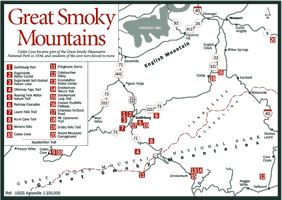
With the approach of the Pleistocene ice sheets, hundreds of plants and animals living in areas far to the north retreated to the higher elevations of the Smokies to escape the climactic impact of the Wisconsin glaciation, in some instances later returning to their former range as conditions improved.
Cold-loving alpine plants and spruce and fir forests were restricted to the highest peaks in the Smokies as a warming trend began about 16,000 years ago. The flora and fauna that found refuge in the Smokies evolved and eventually developed into complex plant communities.
The variety of conditions found within the Smokies on the 14-mile trip from Sugarlands to Newfound Gap is the ecological equivalent of a trip from Georgia to Canada. The average temperature drops up to 3 to 5 degrees Fahrenheit for each 1,000-foot gain in elevation. Altitude varies from 850 feet to 6,643 feet, and average rainfall ranges from 55 inches at Sugarlands to 85 inches on Clingmans Dome.
Within these broad ranges flourishes one of the most ecologically diverse systems in the world.
The cove hardwood forest is comprised of broadleaf trees that exist below 4,000 feet in valleys and coves. These forests were extensively logged because of the huge trees and the varieties this forest type produced.
Cove hardwood forests are filled with spring wildflowers supported by the canopy of white basswood (Tilia americana var. heterophylla), American beech, several varieties of birch, black cherry (Prunus serotina), Eastern hemlock, cucumbertree (Magnolia acuminata), and sugar maple (Acer saccharum). The trees not only provide shade for wildflowers but also their leaves control soil chemistry and provide nutrients as they decompose.
There are still excellent examples of cove hardwoods in a few places missed by loggers before the park was established, notably at the Chimneys Picnic Area on the Newfound Gap Road, at the Albright Grove near Cosby, and at the Greenbrier entrance to the Ramsey Cascades and Porters Flat trails.
Open pine-oak forests are found below 4,000 feet on the thirsty southern and western slopes. These low and middle elevations also support yellow poplar or tuliptree, pignut hickory (Carya glabra), flowering dogwood, rosebay rhododendron (Rhododendron maximum), and mountain laurel (Kalmia latifolia) thickets in addition to table mountain pine, black oak (Quercus velutina), and chestnut oak (Quercus prinus), a favorite food source of deer. Some examples of pine-oak stands can be seen along the Laurel Falls Nature Trail.
Dogwoods, hickories (Carya sp.), black locusts (Robinia pseudoacacia), maples, oaks, and yellow poplars in closed oak forests account for a large part of the outstanding fall foliage displays.
The hemlock forest is dominant on the moist, shady, northern slopes below 4,500 feet along streams. Some of the largest specimens can be seen on the Grotto Falls Trail off the Roaring Fork Motor Nature Trail, and the Alum Cave Bluffs Trail from the Newfound Gap Road. Hemlock forests support an understory of rhododendron, mountain laurel, and dog-hobble (Leucothoe fontanesiana).
Northern hardwood forests consist of yellow birch (Betula alleghaniensis), American beech, maple, and cherry and are found around 4,500 feet. These broadleaf trees, which occur at higher elevations in the GSMNP, are commonly found at lower elevations in northern states. There are examples of this forest type on the road between Newfound Gap and Clingmans Dome.
The spruce-fir forest is the most easily recognized of all of the forest types, because the trees are evergreen: Fraser fir and red spruce (Picea rubens). They grow only on high peaks above 4,500 feet where the climate is similar to that of Maine or Quebec.
The Spruce-Fir Nature Trail along the Clingmans Dome Road from Newfound Gap, and the road itself, pass through stands of these trees. Spruce-fir forests are found along the Appalachian Trail between Clingmans Dome and Mount Guyot on peaks above 5,000 feet that are often cloaked in cloudy mists. Within these mists, suspended particles including sulfur dioxide and nitrogen oxides released during fossil fuel burning react with sunlight to form acids that return to the ground in the form of cloudwater, rain, snow particle, or gas deposition. These acids lower the pH and damage the chlorophyll-producing foliage of the mature Fraser fir and spruce trees. Fraser fir are also under attack from the balsam wooly adelgid, with about 91 percent of the mature Fraser fir population succumbing to the tiny European insect.
Grassy and heath balds are high-altitude open areas that defy the natural laws of succession (see Balds, page 12). Most grassy balds are found in the western portion of the park including Gregory Bald, Spence Field, and Andrews Bald. Heath Balds, known locally as slicks due to the glossy leaves of the rhododendron and mountain laurel that cover them, are brilliant sights in June when spectacular rhododendron blooms cover them.